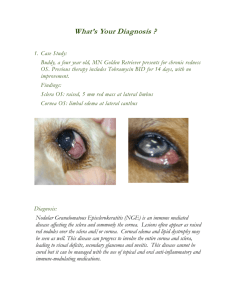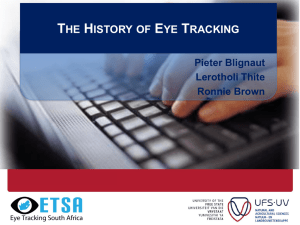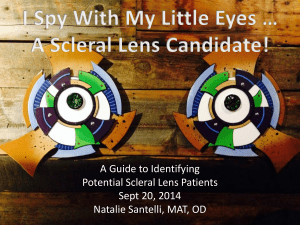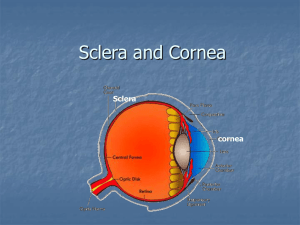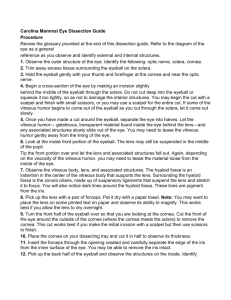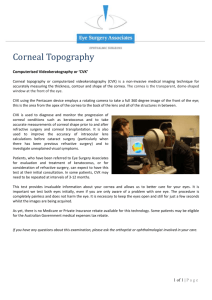corneal_and_scleral_lacerations
advertisement
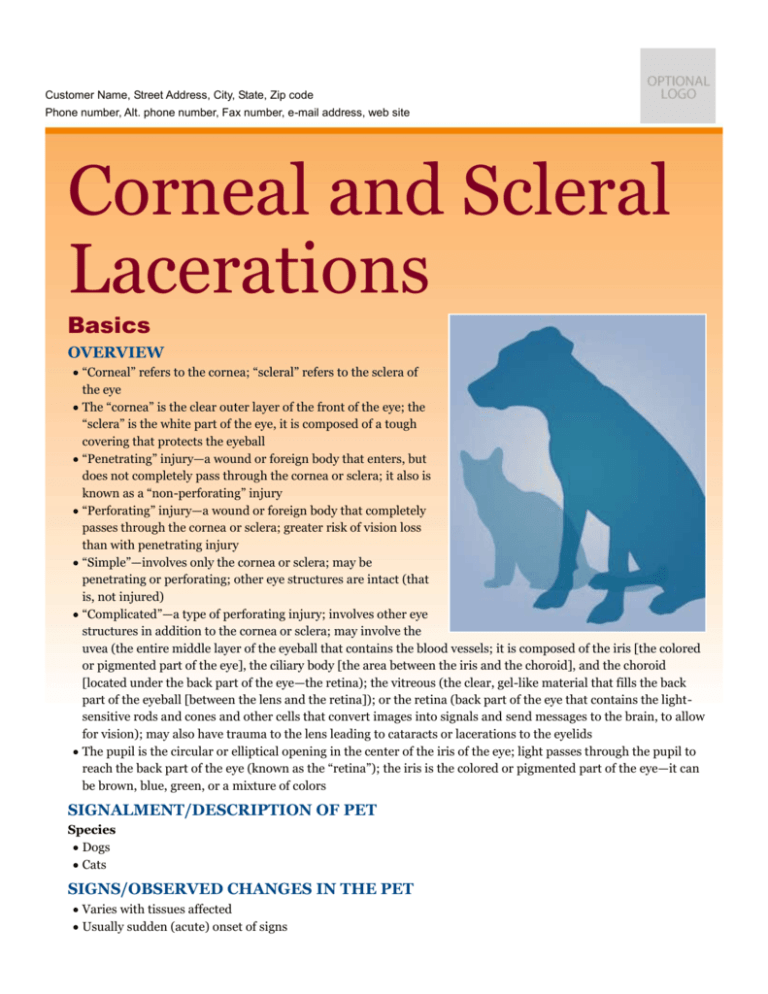
Customer Name, Street Address, City, State, Zip code Phone number, Alt. phone number, Fax number, e-mail address, web site Corneal and Scleral Lacerations Basics OVERVIEW • “Corneal” refers to the cornea; “scleral” refers to the sclera of the eye • The “cornea” is the clear outer layer of the front of the eye; the “sclera” is the white part of the eye, it is composed of a tough covering that protects the eyeball • “Penetrating” injury—a wound or foreign body that enters, but does not completely pass through the cornea or sclera; it also is known as a “non-perforating” injury • “Perforating” injury—a wound or foreign body that completely passes through the cornea or sclera; greater risk of vision loss than with penetrating injury • “Simple”—involves only the cornea or sclera; may be penetrating or perforating; other eye structures are intact (that is, not injured) • “Complicated”—a type of perforating injury; involves other eye structures in addition to the cornea or sclera; may involve the uvea (the entire middle layer of the eyeball that contains the blood vessels; it is composed of the iris [the colored or pigmented part of the eye], the ciliary body [the area between the iris and the choroid], and the choroid [located under the back part of the eye—the retina); the vitreous (the clear, gel-like material that fills the back part of the eyeball [between the lens and the retina]); or the retina (back part of the eye that contains the lightsensitive rods and cones and other cells that convert images into signals and send messages to the brain, to allow for vision); may also have trauma to the lens leading to cataracts or lacerations to the eyelids • The pupil is the circular or elliptical opening in the center of the iris of the eye; light passes through the pupil to reach the back part of the eye (known as the “retina”); the iris is the colored or pigmented part of the eye—it can be brown, blue, green, or a mixture of colors SIGNALMENT/DESCRIPTION OF PET Species • Dogs • Cats SIGNS/OBSERVED CHANGES IN THE PET • Varies with tissues affected • Usually sudden (acute) onset of signs • Often a history of running through heavy vegetation, being hit by gunshot pellets or other projectiles, or being scratched by a cat • Trauma itself may not be observed • Common—corneal, scleral, or eyelid deformity; fluid buildup (known as “edema”) in affected tissues; bleeding (hemorrhage) • May see a retained foreign body • Lacerations often rapidly seal; may appear only as a blood-filled mass under the moist tissues of the eye (known as a “subconjunctival hematoma”) • May also see iris defects; pupil distortion; blood in the anterior chamber of the eye (the front part of the eye, between the cornea and the iris; accumulation of blood known as “hyphema”); cataract (opacity in the normally clear lens, preventing passage of light to the back part of the eye [retina]); bleeding in the vitreous (the clear, gellike material that fills the back part of the eyeball); separation of the back part of the eye (retina) from the underlying, vascular part of the eyeball (known as the “choroid”; condition known as “retinal detachment”); and protrusion of the eyeball (known as “exophthalmia”) CAUSES • Blunt or sharp trauma RISK FACTORS • Preexisting visual impairment • Young, naive, or highly excitable pets • Hunting or running through heavy vegetation • Fighting Treatment HEALTH CARE • Depends on severity • Outpatient—if integrity of the eyeball is ensured • Sedation—consider for excited or fractious pets • When walking—apply an Elizabethan collar and use a harness to avoid increasing pressure in the affected eye Injuries Considered for Medical Treatment • Penetrating or non-perforating wounds with no overriding or gaping of the wound edges—apply an Elizabethan collar; administer antibiotic and/or atropine eye solutions directly to the eye (“topical treatment”) • Penetrating or non-perforating wounds with mild gaping of wound edges or shelved edges—apply a therapeutic soft contact lens and an Elizabethan collar; administer antibiotic and/or atropine eye solutions directly to the eye (“topical treatment”) • Simple full-thickness, pinpoint corneal perforation with a formed anterior chamber and no uveal prolapse— sedentary pets; use a therapeutic soft contact lens and an Elizabethan collar; apply topical antibiotic and/or atropine ophthalmic solutions; reexamine a few hours after applying the lens and at 24 and 48 hours ACTIVITY • Usually confined indoors (cats) or limited to leash walks until healing is complete • A harness is preferred to a collar, to reduce pressure on the neck and the risk of increased pressure within the eye (known as “intraocular pressure” or IOP) and leaking through the wound SURGERY Injuries Requiring Surgical Exploration or Repair • Full-thickness corneal or scleral lacerations • Complicated injuries • Suspected retained foreign body or a scleral rupture involving the back of the eye • Simple, penetrating or non-perforating wound with edges that are moderately or overtly gaping and that are long or more than two-thirds the corneal thickness Injuries Considered for Surgical Exploration or Repair • Small, simple, full-thickness corneal lacerations • Large conjunctival lacerations; the “conjunctiva” is the moist tissue lining the eye • Partial-thickness corneal or scleral lacerations in an active pet Medications • Medications presented in this section are intended to provide general information about possible treatment. The treatment for a particular condition may evolve as medical advances are made; therefore, the medications should not be considered as all inclusive ANTIBIOTICS • Complicated wounds, those with retained plant material, and those caused by blunt trauma with tissue devitalization—infection common • Bacterial infection/inflammation of the tissues within the eyeball (known as “endophthalmitis”)—seen in 5% to 7% of pets with perforations; very rare in wounds that only penetrate, but do not perforate the cornea • Penetrating wound—topical (applied to the eye) antibiotics alone (such as neomycin, polymyxin B, and bacitracin) or gentamicin solution usually sufficient • Perforating wounds—systemic (administered by injection or by mouth) ciprofloxacin (dogs); topical (applied to the eye) cefazolin and fortified gentamicin or tobramycin • Topical (applied to the eye) ciprofloxacin eye solution—may be used instead of the combination of topical cefazolin and a fortified aminoglycoside ANTI-INFLAMMATORY DRUGS • Topical (applied to the eye) 1% prednisolone acetate or 0.1% dexamethasone solution—as soon as the wound is sutured or the surface is healing, if no infection is present • Systemic (administered by mouth) prednisone—for sutured or healing wounds when inflammation is severe; when the lens or more posterior structures are involved; when the wound is infected or not healing and control of inflammation is mandatory to preserve the eye • Topical (applied to the eye) nonsteroidal anti-inflammatory drugs (NSAIDs)—flurbiprofen or one of several other NSAIDs; may be used if topical steroids are not indicated (for example, infection is present) and control of inflammation is mandatory to preserve the eye MEDICATIONS TO DILATE THE PUPIL (KNOWN AS “MYDRIATICS”) AND TO RELIEVE EYE PAIN • 1% atropine eye solution—when significant constriction of the pupil (known as “miosis”) is present or inflammation is identified in the front chamber of the eye (known as “anterior chamber reaction”) MEDICATIONS TO RELIEVE PAIN (ANALGESICS) • Topical atropine or oral aspirin (dogs)—may provide sufficient pain relief; use analgesics only as directed by your pet's veterinarian • Butorphanol—dogs and cats; for mild pain • Carprofen • Tramadol • Oxymorphone—dogs and cats; for sudden (acute) severe pain; when sedation is required Follow-Up Care PATIENT MONITORING • Deep or long penetrating wounds that have not been sutured and perforating wounds—recheck every 24–48 hours for the first several days to ensure integrity of the eyeball, to monitor for infection, and to check control of eye inflammation • Superficial penetrating wounds—usually rechecked at 3- to 5-day intervals, until healed • Antibiotic therapy—altered according to bacterial culture and sensitivity results PREVENTIONS AND AVOIDANCE • Take care when introducing new puppies to households with cats that have front claws • Minimize running through dense vegetation • Consider having a bottle of saline eyewash to irrigate or flush debris from the eye • Minimize visually impaired or blind dogs' exposure to dense vegetation POSSIBLE COMPLICATIONS • Loss of the eye or vision • Long-term (chronic) eye inflammation or pain • Post-traumatic sarcoma, a type of cancer, may develop in blind cat eyes that have been injured severely; consider surgical removal of the eyeball and associated tissues (known as “enucleation”) for all blind, injured feline eyes to prevent post-traumatic sarcoma EXPECTED COURSE AND PROGNOSIS • Most eyes with corneal lacerations or having a retained corneal foreign body are salvageable • The further back the injury is located in the eye, the poorer the prognosis for retention of vision • Poor prognosis—involvement of the sclera (the white part of the eye, it is composed of a tough covering that protects the eyeball) or uvea (the entire middle layer of the eyeball that contains the blood vessels); no light perception; perforating injuries involving the lens; significant bleeding into the vitreous (the clear, gel-like material that fills the back part of the eyeball); or separation of the back part of the eye (retina) from the underlying, vascular part of the eyeball (retinal detachment) • Penetrating injuries usually better prognosis than perforating injuries • Blunt trauma carries a poorer prognosis than sharp trauma Key Points • The full extent of the injury (cataracts, retinal detachment, infection) may not be apparent until several days or weeks after the injury; therefore, long-term follow-up is necessary Enter notes here Blackwell's Five-Minute Veterinary Consult: Canine and Feline, Fifth Edition, Larry P. Tilley and Francis W.K. Smith, Jr. © 2011 John Wiley & Sons, Inc.

